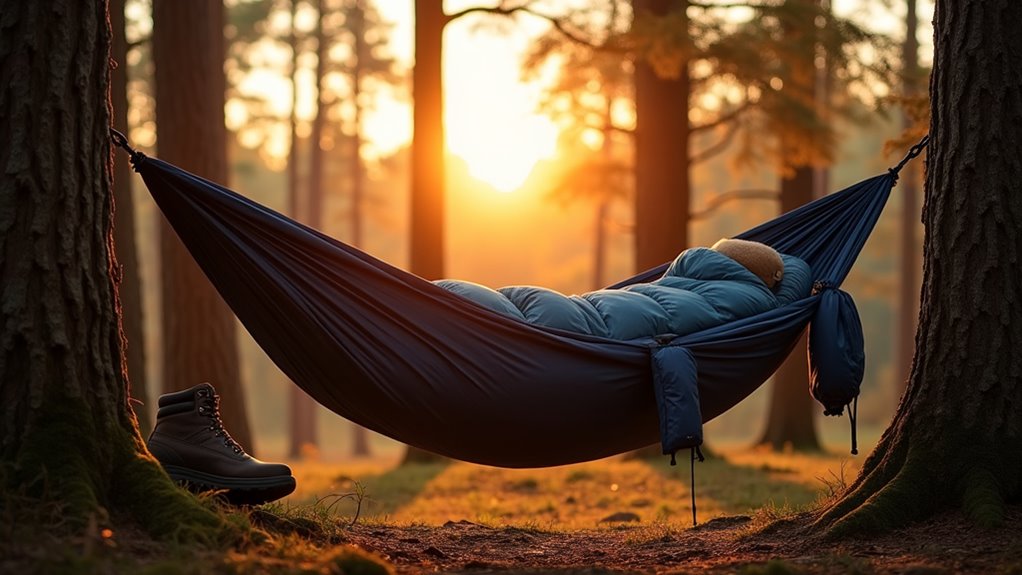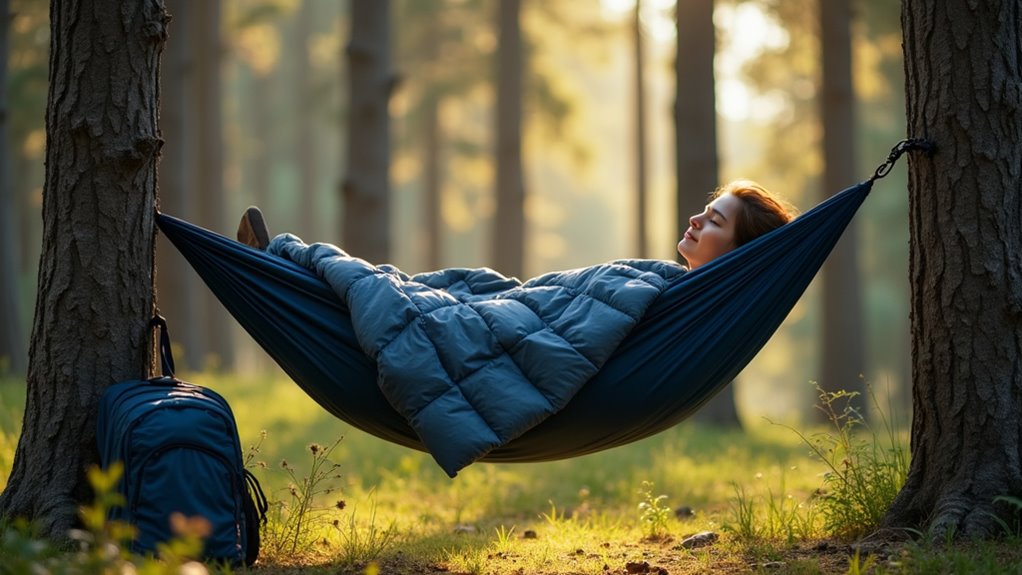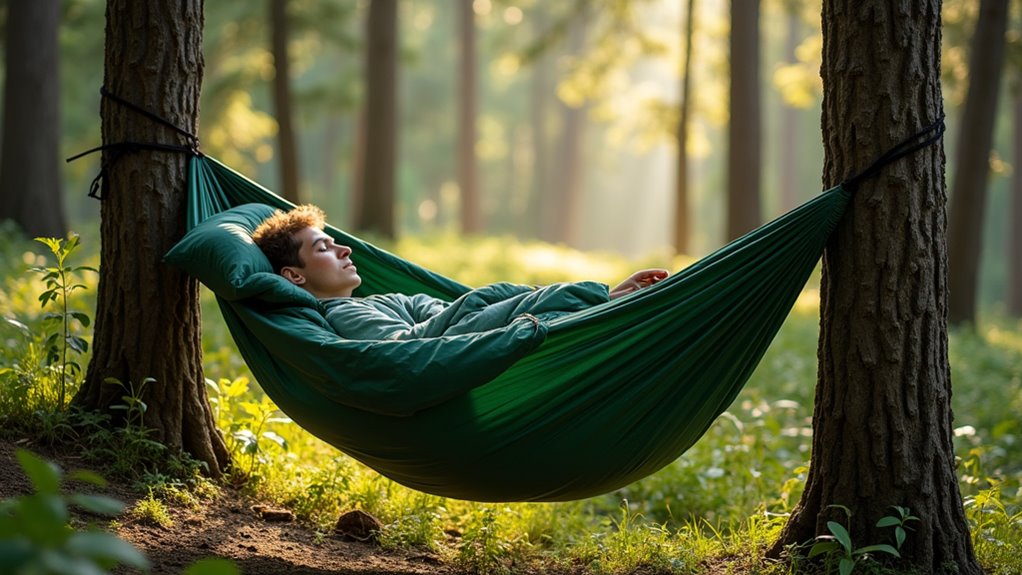Physical Address
304 North Cardinal St.
Dorchester Center, MA 02124
Physical Address
304 North Cardinal St.
Dorchester Center, MA 02124

Transform your outdoor sleeping experience from rocky ground to suspended bliss with camping hammocks that revolutionize wilderness comfort.
Just as you’ve mastered the art of sleeping at home, you’ll find that camping doesn’t have to mean tossing and turning on lumpy ground. You can transform your outdoor rest with a camping hammock, a solution that’s gaining traction among savvy adventurers who want comfort without breaking the bank. Whether you’re a weekend warrior or planning extended trips, these suspended sanctuaries offer more than just a place to crash. Let’s explore how you can elevate your camping experience, literally and figuratively.

As outdoor enthusiasts seek lighter and more versatile camping gear, camping hammocks have emerged as a game-changing solution in the outdoor recreation market. You’ll find these portable shelters growing in popularity thanks to their exceptional convenience and easy setup between trees or posts.
With nearly 28 million Americans camping annually and 49% of the population engaging in outdoor activities, it’s no surprise the camping hammock market is set to grow at 5.9% through 2034. Hammocks are a good camping companion due to their various benefits, such as improved comfort and weight-saving advantages.
Growing outdoor recreation and camping trends point to a surging demand for camping hammocks in the coming decade.
You can join the growing community of backpackers, researchers, and wildlife enthusiasts who’ve discovered hammocks’ practical benefits. They’re perfect for everything from overnight wilderness adventures to casual park visits, offering a comfortable way to disconnect from technology while staying close to nature.
Plus, their compact design makes them ideal for budget-conscious travelers who need to pack light. Modern camping hammocks are crafted from nylon and polyester materials that ensure durability while maintaining lightweight characteristics.
When selecting a camping hammock, you’ll need to evaluate several critical features that determine both comfort and durability.
Look for models made from high-denier nylon or polyester fabric, with nylon offering better tear resistance and stretch. You’ll want tree-friendly suspension straps and reliable carabiners rated for your weight plus gear.
Choose a hammock that’s at least two feet longer than your height, with an asymmetric design for a flatter sleeping position. Setting up at a 30-degree angle provides the ideal balance of comfort and structural support.
Top hammocks for your next camping adventure can provide additional inspiration for your hammock selection.
Don’t forget essential accessories like rain tarps and bug nets for weather protection. Storage features such as underfloor pockets keep your gear organized and dry.
For cold-weather camping, invest in an underquilt for insulation. Check for reinforced stitching at stress points and UV-resistant materials to guarantee your hammock lasts through many adventures.

Selecting the right hammock size and style builds on the quality features you’ve identified, making it a key step in your purchase decision. When choosing your hammock, focus on matching your specific needs with appropriate dimensions and design.
Size and style are crucial factors when choosing a hammock – match your needs with the right dimensions for optimal comfort.
Don’t forget to factor in your gear weight when calculating capacity needs, and consider integrated features like bug nets for camping-specific models.
Understanding the materials and construction of your camping hammock can make the difference between a reliable shelter and a risky purchase. Ripstop nylon leads the pack for its excellent durability and repair-friendly nature, while HyperD offers a fantastic lightweight alternative if you’re counting ounces on the trail.
You’ll want to pay attention to the denier rating – 70D nylon provides a sweet spot between comfort and durability, while 20D serves ultralight enthusiasts. Essential camping gear for your canine companion should also be considered when selecting a camping hammock.
For construction, guarantee your hammock features a 1-inch seam allowance and reinforced edges to prevent fraying. AmSteel cording paired with cinch buckles makes for a trustworthy suspension system that’s easy to adjust. The ideal hammock should include a 4.5-meter tension string for proper support and stability.
If you’re handy with a sewing machine, DIY options can save you money while allowing full control over materials and features.

A safe hammock setup begins with proper site selection and attention to detail. You should choose trees that are at least 8 inches in diameter and properly spaced to support your weight. Remember to hang your hammock no higher than 18 inches off the ground and maintain a 30-degree angle with your suspension straps. Setting up a bug net system will ensure a peaceful night’s sleep without insect disturbances. Choosing the right hammock material can also contribute to a comfortable camping experience.
For a successful setup, follow these key steps:
Always check local regulations regarding hammock use and follow Leave No Trace principles. Keep your emergency kit nearby and regularly inspect all components for wear and tear.
When it comes to sleeping comfortably in a hammock, proper positioning and insulation make all the difference.
You’ll need to lie diagonally across your hammock to flatten your body posture and reduce pressure points. Choose a hammock that’s around 11 feet long and 64 inches wide to give yourself plenty of space to stretch out.
Don’t overlook the importance of insulation. You’ll lose significant heat from underneath, so invest in an underquilt rather than relying on a traditional sleeping pad. Pair it with a sleeping bag for complete warmth. Camping hammocks provide great relaxation and comfort for outdoor enthusiasts.
In warmer weather, you’ll appreciate the gentle rocking motion helps promote deeper, more restful sleep throughout the night.
For the best sleep, use a structural ridgeline to maintain the ideal sag and shape.
Consider a model with an integrated bug net to keep insects at bay while maintaining airflow.

Proper weather protection can make or break your hammock camping experience, regardless of the season.
You’ll need to adapt your setup based on weather conditions while keeping essential protection methods in mind. Setting up higher will help avoid ground-level moisture and splashing during heavy rainfall.
To guarantee you’re prepared for any weather situation:
Choose sheltered spots when possible and position your hammock to minimize exposure to wind and rain while maximizing natural protection from surrounding terrain. Creative cooking hacks can also be helpful for your next camping trip.
Beyond weather protection, selecting the right hammock model can make your camping adventures more enjoyable and efficient.
If you’re looking for customization, the Dutchware Chameleon lets you tailor everything from bug nets to fabric types. For ultralight backpacking, consider the Warbonnet Blackbird or Kammok Mantis UL, which both excel in weight-to-feature ratio. After extensive comfort testing data, with feedback from testers ranging from 5’5″ to 5’11”, these options consistently deliver superior sleep quality.
On a tight budget? The Onewind Tempest offers impressive value with its adjustable ridgeline and bug net. Comfortable Camping Beds can also provide a restful outdoor sleep experience.
If you want an all-in-one solution, the Kammok Mantis UL includes everything you’ll need, from tarp to suspension system. For minimalists, the Dream Hammocks Darien delivers a straightforward, lightweight design without unnecessary frills.
Each model serves specific needs, so match your choice to your camping style and requirements.
You’ll find that camping hammocks revolutionize outdoor sleeping, challenging the old notion that ground tents are the only way to camp comfortably. By investing in a quality hammock system with proper suspension, insulation, and weather protection, you’re actually saving money over expensive tent setups while gaining versatility. Test this theory yourself – once you’ve mastered the proper hanging technique, you’ll never want to sleep on the ground again.